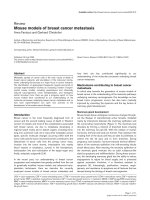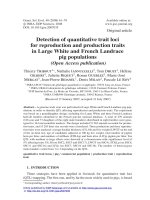Recent models of linking science technology, education - training and production business in Vietnam
Bạn đang xem bản rút gọn của tài liệu. Xem và tải ngay bản đầy đủ của tài liệu tại đây (212.47 KB, 11 trang )
44
Recent models of linking science-technology, education-training and production…
RECENT MODELS OF LINKING SCIENCE-TECHNOLOGY,
EDUCATION- TRAINING AND PRODUCTION-BUSINESS
IN VIETNAM
MSc. Hoang Van Tuyen
National Instutute for Science and Technology Policy and Strategy Studies
Abstract:
The aspects of linking three sectors Science-Technology, Education- Training and
Production-Business in Vietnam during recent time are proceeded and reflected in
numerous decisions and policies of the Communist Party of Vietnam, the Government and
the Prime Minister 1. In addition to them, the number of research works, scientific
workshops and conferences held to identify solutions to reinforce links between these
sectors. This paper is to summarize some typical models of linking these sectors in Vietnam
during recent time.
I. LINKS AND ROLES OF LINKS BETWEEN SCIENCETECHNOLOGY, EDUCATION-TRAINING AND PRODUCTIONBUSINESS
The conception of these links called in some ways as relation, cooperation
and connection is used to reflect the different types of integration between
three sectors Science-Technology, Education-Training and ProductionBusiness for purpose to exchange knowledge, technologies and skills. These
types of interaction can be direct or indirect ways to facilitate the diffusion
of knowledge, technologies and skills. They are taken as one of the most
important factors of the process of learning and innovating. The links
between these sectors are beneficial for participating sides [2, 3]. The
reasons are explained as follows.
First, for the sector Science-Technology and Education-Training: During
this process of exchange researchers, scientists and lecturers can get new
ideas and proposals merging from their research works of others. Their
1
Typically, Resolution No. 37 of the PolitBuro (IV Congress), Resolution No. 26 of the PolitBuro (VI Congress), Resolution No.
01 of the PolitBuro and Resolution of the 7-th Session of the Central Committee (VII Congress), Resolution of the 2-nd Session of
the Central Committee (VIII Congress), Decision No. 134/HDBT dated 31 August 1987 of the Council of Ministers (Government),
Resolution No. 35-HDBT dated 28 January 1992 of the Council of Ministers (Government), Decision No. 324-CT dated 11
September 1992 of the Chairman of the Council of Ministers (Prime-Minister), Decision No. 782/TTg dated 24 October 1996 of
the Prime-Minister, and etc.
JSTPM Vol 1, No 2, 2012
45
research works may provide constructive suggestion and supports from
their members so that they can upgrade the level of their research works
aiming at carrying out larger projects and programs. Young students may
get involved into research and, by this way, they would start their research
activities early and it will improve students’ skills. Researchers in
universities and research institutes have chances to cooperate with their
colleagues in larger projects2 where the coordination and mobilization of
common knowledge and efforts are required. These links would motivate
and encourage students in further activities of research and help them like
it.
In addition to the State budgets allocated for research programs, enterprises
would additional financial supports for research activities of universities
and research institutes. The volumes of these supports, in many cases, are
bigger than the one of the State allocated budgets. The links to activities of
the sector Production-Business would encourage and offer chances of access
to practical activities. Researchers would have larger rooms to test and
implement their ideas and proposals.
These links increase also the effectiveness of use of research infrastructure
in universities and research institutes. They would help students to set up
their own proposals for research projects and develop their entrepreneur and
business spirits. Students would have also chances to link their theoretical
studies and practical applications (learning by doing, learning by studying).
As result, all the research infrastructure of universities and research
institutes are used with higher efficiency.
Second, for the sector Production-Business: Innovative enterprises take
science-technology activities as a main part of their development. By this
way they try to produce high quality products, enhance their self-control
capacities and technology application potential, adapt and upgrade import
technologies, look for advanced technologies, save their currency budgets
and extend their export markets.
Improving technological capacities of enterprises: The market’s tough
competition requires enterprises to enhance their technological capacities
through the establishment of centers for research and design to produce high
competitive products. These centers can be established jointly with
universities and research institutes. When doing investment for sciencetechnology, the enterprises expect not only to renovate their technological
capacities but also to develop their capacities to identify, absorb and use
exterior necessary knowledge. By other words, enterprises, when pushing up
2
Research institutes mean R&D institutes or centers; Universities mean universities, colleges or academies.
46
Recent models of linking science-technology, education-training and production…
their links to universities and research institutes, would target to pmomote
their technological absorption capacities. The earned capacities would let
them use efficiently the know-how they get from outsite
Strengthening the position of enterprises: In technological market, the
buyers, if getting more and better information, would take more advantages
in their technological deals because they can have advanced solutions for
application. They also would be better positioned in selecting technology
providers and upgrading provided technologies.
Extending export activities of enterprises: Those enterprises which develop
their science-technology potential would have better chances to sell their
products in the markets which do not have equivalent products, particularly
for products manufactured with new technologies. The successful
investment for science-technology would lead to higher competitive
products and then to higher revenues and further to higher income for reinvestment for science-technology research activities. The full cycle of
strategies for investment-production-income-investment would continue.
Securing faster development and growth rates of enterprises: Naturally the
production and commercialization of new and innovative quality products
would let enterprises secure a better market share and new market extension.
These new capacities would help enterprises secure higher development
and growth rates.
II. MODELS OF LINKS
1. Model of organizations (“Hard” form)
1.1. Science-Industrial union or consortium
This form of links is established on basis of universities and research
institutes and industrial production-business and service enterprises. From
the point of functional targets this form is focused to shorten the path from
research and training activities to production and commercialization of
products. The full cycle would be Research-Training-ProductionCommercialization [4].
1.2. Universities and research institutes in enterprises
This form becomes popularly applied in developed countries, particularly in
large groups or corporations. They would set up universities and research
institutes to serve their own needs in domestic and overseas markets.
JSTPM Vol 1, No 2, 2012
47
1.3. Businesses in universities and research institutes
The estalishment of businesses in universities and research institutes targets
not only to cover partially the shortage of the State budget allocation but
also to become an important component in the cycle Research-TrainingProduction-Commercialization.
1.4. Institutes in universities
In developed countries, the research activities of institutes are conducted in
their laboratories or programs. In Vietnam, this form targets closer links
between research and teaching activities. In this form the institutes connects
toughly scientific research activities to production-business activities.
1.5. Science/Research parks, Technology parks, Science cities, High-tech
parks, High-Tech Agricultural zones, Technology-based firm incubators,
Technopolis, Innovation centers, Centers of excellence, Technology transfer
organizations, Technology License organizations are those forms which are
newly applied and extended in Vietnam.
2. Model of exchange (“Soft” form)
In addition to the above mentioned “hard” forms there exist some flexible
forms which are regularly applied, namely the mobility of scientific staffs
between regions, diffusion of scientific publications, diffusion of knowledge
during workshops, conferences, IP patents, technological capacity building
activities for SMEs, awareness and use of technological management
techniques, innovative management practice, knowledge management and
quality management. Under these forms universities and research institutes
also participate in technological research and innovation projects of
enterprises.
Therefore, all the models (“hard” or “soft”) of links would be oriented to
enhance the exchange of knowledge, technologies and skills between the
three sectors Science-Technology, Education-Formation and ProductionBusiness. The links could be direct or indirect channels of transfer, official
or unofficial, organization-based or individual-based. Table 1 summarizes
some basic incentive forms of links.
48
Recent models of linking science-technology, education-training and production…
Table 1. Some basis incentive forms of links
No.
Form of link
Description of links
1.
Research cooperation of
science-technology
projects
Conducting scientific research activities in laboratories,
universities and research institutes
2.
Order for research and
training
Implementing research activities and formation of
scientific staffs according to negotiations/agreements
among enterprises and universities and research
institutes
3.
Cooperation in
technological
innovation projects
Conducting the cooperation among enterprises and
universities and research institutes in technological
innovation projects, consulting service or information
provision for enterprises to conduct their innovation
activities
4.
Exchange of staffs or
special mission trips of
staffs
Conducting the exchange of staffs where the ones of
enterprises would joint some research and training
activities of universities and research institutes
5.
Joint use of equipment
and other infrastructure
facilities
Conducting jointly tests or analysis of samples in
universities and research institutes
6.
Application and
commercialization of
research results
Implementing agreements for technological transfer
from universities and research institutes to enterprises
7.
Other links
Joint publication of science-technology works.
Joint organization of workshops, seminars, panels,
round tables, scientific councils and some others.
III. SOME TYPICAL MODELS OF LINKS IN VIETNAM DURING
RECENT TIME
1. Model of links between the sectors of Science-Technology and
Education-Training
According to this model (Research Institute-in-University model) the
research institutes are established in universities. This model was developed
in Vietnam since the years 1980s. It gets more popular particularly since
Resolution No. 35-HDBT dated 28 January 1992 had been promulgated by
the Council of Ministers (now is the Government). Actually there are more
than 100 research institutes which were established in universities over the
whole country. The number of these research institutes is increasing. The
most typical establishment of these research institutes is seen among
technological universities and regional universities, namely Hanoi
University of Technologies, Ho Chi Minh City University of Technologies
JSTPM Vol 1, No 2, 2012
49
(Ho Chi Minh City National University), Da Nang University of
Technologies, Thai Nguyen University, Can Tho University and some
others. Actually this form of research institutes demonstrates the efficient
activities in implementing jointly the teaching activities and scientific
research activities.
2. Model of links between the sectors of Science-Technology, EducationTraining and Production-Business
2.1. Science-Production Unions
The model of Science-Production Unions was established since the years
1980s. These unions cover the long range of activities from research
(emerging scientific ideas) to final products. The unions are estalished in the
following ways [4]:
Way 1: Research institutions linked to production-business enterprises. For
example: Southern Vietnam Region Information-Television ScienceProduction Union which was form on basis of the Radio-television Institute
and some electronic-mechanical workshops. They have the full legal status
and strong scientific research potentials. They are capable to conduct works
of research, design, manufacture, installation and operation of local radiotelevision facilities and electronic and measurement equipment.
Way 2: Research institutes connected to design institutes and productionbusiness enterprises. For example: Ho Chi Minh City Chemical ScienceProduction Union which was set up under Chemical Industry Research and
Design Center (having the full legal status) and some chemical productionbusiness enterprises (namely, Linh Xuan Chemical Enterprise, Phuoc Long
Chemical Enterprise, Phu Nhuan Chemical Enterprise not having the full
legal status). The newly set up union conducts research works in the field of
natural compounds, polimers, anti-erosion compounds and micro-biology.
Way 3: Spin-offs of research institutes. For example: Hanoi Chemical
Science-Production Union which was established on basis of Industrial
Chemistry Institute. The Institute has strong production-business divisions to
carry out works in fields of inorganic and organic chemistry, fertilizers, petrochemistry and plant protection chemicals. These divisons become specialized
centers with the full legal status. They operate on basis of financial selfmanagement scheme.
Globally, Science-Production Unions are the initial pilot stage to set up the
models of link with higher level of efficiency and investment. The majority
of these unions have their own scopes of activities oriented to actual market
needs. Actually this model stopped being applied largely. Only a few of
50
Recent models of linking science-technology, education-training and production…
them remain operational, namely the ones of the Vietnam Academy of
Science-Technology (VAST), the Military Academy of Science-Technology
(MAST) and the Vietnam Union of Science-Technics Associations
(VUSTA).
2.2. Enterprises set up in universities and research institutes
During the process of development many universities and research institutes
set up their own production-business enterprises [6] depending on their
actual status and fields of activities.
First, these enterprises have their own legal status, taxation registration and
production-business license. They are under administrative management of
universities and research institutes and they are to carry out productionbusiness activities based on research results which the universities and
research institutes developed.
Second, some universities and research institutes remain in their tertiary
status but eligible to set up their own production-business divisions. These
divisions have their own legal status, taxation registration and business
license. These universities and research institutes can conclude productionbusiness contracts with other entities by using the legal status of these
divisions.
Third, technological incubators are set up as starting enterprises. These
technological incubators are to implement production-business activities as
pilot facilities. The universities and research institutes would provide
infrastructure facilities and services to encourage their staffs to set up
production-business projects based on their own research works. Councils
are set up in universities and research institutes to approve the list of
researcher-staffs to work in these incubators. These incubators do not have
the legal status for production-business activities and therefore the
universities and research institutes facilitate the joint activities (namely,
joint venture enterprises) with other entities having the full legal status for
production-business activities. These entities are, in fact, their partners or
customers to complete the cycle research-production-commercialization.
The typical example of this model is the Software Technological Zone of
Ho Chi minh City National University who had set up Integrated Circuit
Design-Research-Education Center (ICDREC).
Fourth, spin-offs are set up being based on new technologies. They are
those divisions of universities and research institutes having new
technologies to set up new enterprises. From organizational point of view,
these spin-offs can be established as joint business entities between
universities, research institutes and enterprises. These spin-offs may have
JSTPM Vol 1, No 2, 2012
51
the multi-ownership status. The typical examples of this type include the
Petroleum Additive and Product Development Company (APP), some spinoffs of the VAST and MAST. The number of these spin-offs grows very fast
during the last decade, particularly after the promulgation of Resoultion No.
80/2007/ND-CP dated 19 May 2007 by the Government [1].
2.3. Institutes developed by enterprises
This model is among the most “optimal” solutions to link the research to
production-business. This model is very popular in almost all the developed
nations. In Vietnam the State authorities are in the way to set up the “legal
corridors” for the favorable development of this model. The measures may
have some administrative regulations to turn research institutes to
enterprises (Decision No. 782/TTg dated 24 October 1996) or other
incentive measures for enterprises to set up their own universities and
research institutes. But this model can be applied only for corporations or
big companies. According to the figures collected by the author [3], by the
end of 2010 the corporations and big companies have set up 27 research
institutes, 73 research centers and 4 universities. The successful examples of
this model are VNPT (Vietnam Post and Telecommunication), EVN
(Electricity of Vietnam), FPT and some others.
2.4. Institutes set up by enterprises of universities and research institutes
The typical example of this model is the IMI Holding Company. It is an
institute working in the field of industrial machines and tools. The institute
had established many dependent enterprises and these enterprises, at their
turn, set up their own research centers or divisions. The typical case of this
model is the Industrial Electronic Company (CDC), a member of the IMI
Holding Company, who sets up its own Science-Research-Development
Department.
3. Model of science-technology, education-training, production-business
a) The union of science-training-production. Ealier, the number of
organizations belong to this model. However, this type almost is not
maintained or replaced by other form of activity.
b) The incubator zones set up in universities (Institutes in the incubator
zones). The typical example of this model is the Software Technology Zone,
Vietnam National University - Ho Chi Minh City to establish the Intigrated
Circuit Design Research and Education Center (ICDREC).
c) Enterprises set up by institutes of universities. This model presents
enterprises are set up by institutes of universities. Institutes are seen as the
52
Recent models of linking science-technology, education-training and production…
core factors to implement the all three functions of science reseach,
application of reseach results to teaching programs and production-business.
d) Enterprises set up institutes and universities. This model shows that huge
cooperations and big businesses with their strong potentials. In Vietnam,
some of the typical ones are the Vietnam Posts and Telecommunications
Group, Vietnam Electricity, FPT Telecom and others.
4. Model of high tech zones and incubators
The typical examples of this model are Hoa Lac High Tech Zone, Ho Chi
Minh City High Tech Zone and Quang Trung Software Industrial Zone. In
addition to these zones there exist some high tech application agricultural
zones in some provinces including the private ones.
5. Model of institutions having the direct participation of local
administrative government
The typical examples of this model are the programs to support research and
technological renovation of local enterprises (namely, programs to support
the manufacture of low cost equipment of Ho Chi Minh City - CT04
Program, and programs to link State authorities, scientists, farmers and
businessmen of some local administrations including the productionbusiness program of the Hanoi administration) [5].
6. Model of agreements
This model is realized under various forms: i) Enterprises and universities
and research institutes closely cooperate in joint programs of research and
technological renovation, ii) Enterprises support the full investment for
universities and research institutes and individual scientists to carry out
projects of research and technological renovation, renovation and upgrading
of products of the enterprises, iii) Agreement for mobility of scientific
staffs, iv) Agreement of training and supervising research works of students,
and v) some other forms of agreement. The following box illustrates some
typical cases of cooperation for training between universities and enterprises
[3].
Intel Product Company had conducted the survey for assessment of training
programs and training capacities including teaching staffs, teaching
documents, laboratories. They meet and interview students of specialties
electro-electronics,
information
technologies-communication,
manufacturing-engineering of 5 universities, namely Da Nang University,
Hanoi University of Technologies, Ho Chi Minh City University of
Technologies, Hochiminh City Industry University and Hochiminh City
JSTPM Vol 1, No 2, 2012
53
University of Technical Teachers Formation. Under the survey’s results,
Intel Product Company had conducted further steps of cooperation including
the signature of contract with Da Nang University where it indicates the
requirements of training quality, financial supports for labs, etc.
The univesities, from their side, get more active in their approach to
enterprises. They set up teaching programs oriented to needs of enterprises.
The enterprises, from their side, give the favorable conditions and even
financial assistance for practical works of students. Ho Chi Minh City
University of Information Technologies (Ho Chi Minh City National
University) had signed with Microsoft the agreement for joint training of
human resources.
Another example is the cooperation agreement signed between Economics
Department of Ho Chi Minh City National University and Hoa Sen
Corporation for supply of high quality human resources and support for
development. The agreement shows well the trust by end-users and the
reputation of the training university. The cooperation between Hoa Sen
Corporation and Ho Chi Minh City National University extends also to the
field of scientific research and application, scholarships and on-site practical
training for students.
Other examples include the cooperation between Kaisa Consulting, SAP and
Software Industrial Zone of Ho Chi Minh City National University, the
need-based training programs between Hanoi Economics University (Hanoi,
National University) and 6 enterprises, namely: Nomura (Japan), GAMI,
Hanoi Securities Company, Hanoi Association of Businesses, An Binh Bank
and Ocean Bank. Hanoi University of Technologies concludes also many
need-based training programs with the business community.
Conclusion
Vietnam has made considerable efforts to set up the links between the
academic sector (universities and research institutes) and the productionbusiness (enterprises). These links cover the large range of models (hard and
soft, central controlled and local managed). All of these models target the
consolidation of advantages and the reduction of obstacles in the
cooperation relation between the academic sector and the productionbusiness sector.
54
Recent models of linking science-technology, education-training and production…
REFERENCE
1.
Hoang Van Tuyen. (2005) Studies of financial investment forms for sciencetechnology enterprises. Research Project Report, National Instutute for Science and
Technology Policy and Strategy Studies.
2.
Hoang Van Tuyen. (2007) Studies of factors impacting R&D activities of enterprises.
Research Project Report, National Instutute for Science and Technology Policy and
Strategy Studies.
3.
Hoang Van Tuyen. (2010) Studies of development policies for organization and
implementation of science-technology activities in large corporations in Vietnam.
Research Project Report, Ministry of Science and Technology of Vietnam.
4.
Nguyen Van Hoc. (1998) Upgrading the management mechanism of R&D
organizations in the market economy context of Vietnam. Ministerial Research Project
Report, Ministry of Science and Technology of Vietnam.
5.
Hoang Xuan Long. (2005) Studies and analysis of some models to link universities
and research institutes to enterprises for development of new technologies. Research
Project Report, Ministry of Science and Technology of Vietnam.
6.
Pham Quang Tri. (2008) Studies of the development of R&D organizations in some
selected countries and Vietnam. Research Project Report, National Instutute for
Science and Technology Policy and Strategy Studies.









